Tripping the Rift: Interviews: Director Bernie Denk
This is the transcript of the April 24th SadGeezer.com interview with Tripping the Rift Director Bernie Denk about his work in animation and on our favourite 3D cartoon.
Headgehog) How did you get involved in animation?
Bernie Denk) I didn’t start out in animation. I first studied Fine Arts at Dawson College in Montreal. After college I was lucky enough to meet Gerry Potterton. He was an animation director and was about to start the first “The Heavy Metal” movie. He gave me my first chance by letting me work on it. I never looked back.
HH) And what about 3D animation?
BD) I first learned about 3d work during my 7 years working at Trickompany studio in Germany, I spent a year learning 3d animation in my spare time.
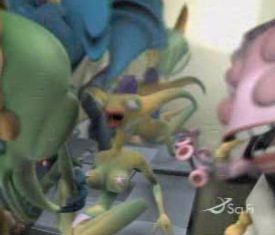 HH) what projects did you do over in Germany?
HH) what projects did you do over in Germany?
BD) I directed animation on a feature called “Felidae”. It was a murder mystery story with realistic cats. I did ok in Germany, but never made it to America unfortunately. I helped produce 300 one min 3D shorts for a German TV kids station. Little jokes that happened during commercials.
HH) Didn’t you direct Disney’s Doug about that time?
BD) I was offered to direct Doug for two seasons, so I left Germany and moved to New York City. Doug did very well, it was nominated for Emmy’s both seasons, unfortunately it didn’t win. After that I returned to Canada and started doing some freelance animation for a studio I used to work for called Cinegroupe.
HH) What are you currently working on?
BD) I’m directing a 3D Halloween special called Spookley the Square Pumpkin. It’s about a pumpkin whose shunned by everyone because he’s square, but at the end of the day saves the day because he’s special. I have my own production company, Oddvious Animation, producing it.
HH) Are you a science fiction fan?
BD) Not a really huge fan, but I do watch and enjoy many science fiction shows. Many of the TTR crew weren’t fans of science fiction and it was something they had to research sometimes when designing the show. However this wasn’t always crucial since we still consider TTR to be more of a social satire than a sci-fi show.
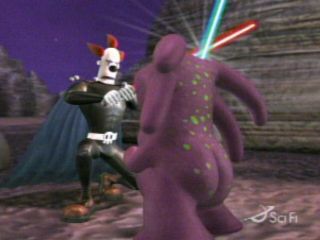 HH) Did you know about the original 5 min movie Tripping the Rift, before you became the director for the show?
HH) Did you know about the original 5 min movie Tripping the Rift, before you became the director for the show?
BD) Yes I remember seeing the short. I though it was great and had a lot of potential
HH) How did you come to work on Tripping?
BD) Mitch Lemire, VP in charge of animation at Cinegroupe asked me one day if I had heard of the short. He told me that Cinegroupe had just acquired the rights for it and were planning to do a series. He thought I would be the right person to direct the series.
HH) What were your favourite episodes of the series?
BD) Hard to say. Of course I liked all the episodes in their own way. God is our pilot, Love Conquers All…err almost and Emasculating Chode where especially nice visually.
HH) What kind of visual techniques gave the show it’s unique look?
BD) Special care was spent on the lighting. This is often something that is neglected on other shows. When done properly it adds a lot of realism. A z-pass was created for every shot in order to add depth of field and we also used a film grain filter in compositing to reduce that ultra clean 3D look and make it look more like live action film. We wanted to move away from shows like Reboot which are too video game like.
HH) What changes were done to the show from the original short?
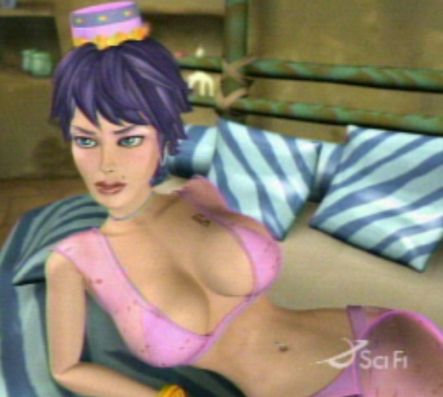 BD) Six underwent the most changes. There were like 20 versions drawn of her before everyone, especially at Sci Fi, agreed on a design. Her hair was shortened a lot and her dress was redesigned to look more hip and sexy. Little things were added like her tattoo: which is the number 6 in old mandarin Chinese. Kind of a “made in china” joke.
BD) Six underwent the most changes. There were like 20 versions drawn of her before everyone, especially at Sci Fi, agreed on a design. Her hair was shortened a lot and her dress was redesigned to look more hip and sexy. Little things were added like her tattoo: which is the number 6 in old mandarin Chinese. Kind of a “made in china” joke.
HH) What about her personality?
BD) Six has changed a lot there too. She was originally a bimbo, but Sci-fi channel wanted a smarter girl for the character. So she became Six: science officer / sex slave.
HH) Who made Gus so gay?
BD) Gus was supposed to keep the crew guessing “is he or isn’t he gay?”, but Sci Fi for some reason insisted that it be much more apparent that Gus was gay. Gus was first voiced by Kevin McDonald, but after recording several episodes Sci Fi decided they wanted a different actor and eventually settled on Maurice LaMarche.
HH) How was Whip changed?
BD) Whip was originally this 35 year old guy who never really did anything. Nobody knew how he got a board or why Chode was letting him stay there. Eventually he became a teenaged slacker and Chode’s nephew. We’ll find out about that in the second season I’m sure.
HH) What happened to the Free Enterprise?
BD) Copyright laws. Our lawyers were cautious and said it was too close to the Enterprise, so we couldn’t use it. Sci-fi came up with the new name Jupiter 42. It’s a play on the Jupiter from Lost in Space.
HH) And the 42 is a play on the Hitch Hikers Guide?
BD) I suppose so.
HH) What happened to all the background jokes? There were so many in the pilot, and then dropped to almost nothing.
BD) Creative differences with the script editors did not allow us much leeway from the network approved scripts. It’s too bad, we think more visually than writers and could have contributed much more, let’s hope things change in the second season.
HH) That’s really a shame because the background jokes were great. Did Sci Fi have that much say in the show?
BD) Sci Fi controlled almost everything. We would send them episodes, and they’d make lots of comments on things they wanted changed, even script issues. It was the main reason for the delay in airing the show. But they were willing to pay and wait the extra time, so we made the changes.
HH) What kind of changes?
BD) Things like characters design, storylines, jokes, censorship, etc…
HH) How much did they ultimately censor?
BD) We thought there would be a lot more freedom, this being an adult show and all. The scripts sometimes had very coarse language and the visual’s called for some explicit sexual situations. We designed and animated accordingly but Sci Fi got cold feet at the last minute and started calling retakes, asking us to censor words, nipples, pubic hair and entire scenes. The 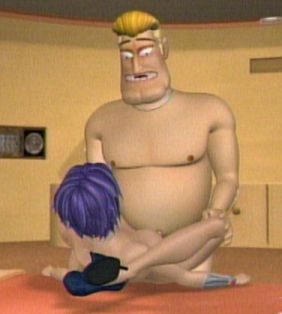 uncut versions do exist, and some foreign networks want the uncut episodes. The DVD’s will be uncensored.
uncut versions do exist, and some foreign networks want the uncut episodes. The DVD’s will be uncensored.
HH) Did they have you censor anything really stupid?
BD) In Power to the Peephole, they thought that too much of Goodman’s butt crack was showing in one scene. I was like, Chode is naked in all thirteen episodes, and he’s got a huge buttcrack! Plus Goodmans’ buttcrack was no larger then what you’d might expect from a plumber.
HH) So there will be a DVD?
BD) Definitely a DVD and other merchandise. I don’t know what they plan to merchandise exactly, a Six blow up doll maybe?
HH) That would probably sell very well. If the hits in the downloads section are any indication. There are plans for a video game?!
BD) A video game will likely be released during the second season. There’s lots of gaming studios here in Montreal that could do the game.
HH) What other countries have expressed interest in the show?
BD) When we previewed the series at the MIP convention in Europe we got a lot of interest. Germany, UK, France all picked it up and many more will follow.
HH) How has the show changed from its original concept?
BD) The show was originally supposed to be a sitcom with a limited cast of characters. But as the show evolved it became more of an action/ 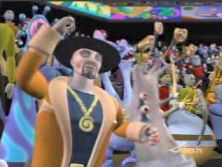 adventure cultural parody. Scripts sometimes called for caricatures of famous people or auditoriums filled with thousands of spectators. I thought to myself “Oh my God!” Tripping was becoming one of the most complex animated series ever. Fortunately we had some of the best creative and technical talent around.
adventure cultural parody. Scripts sometimes called for caricatures of famous people or auditoriums filled with thousands of spectators. I thought to myself “Oh my God!” Tripping was becoming one of the most complex animated series ever. Fortunately we had some of the best creative and technical talent around.
HH) What kind of animation methods did you use?
BD) We did only keyframe animation. Sci Fi pushed for motion capture, but I think its more work, because you just have to go back and tweak everything anyway. What you end up with is realistic movement with nothing special about it. I wanted more cartoony animation which could only be achieved by keyframing. I’m very happy with the results.
HH) How long does it take to create a character?
BD) Modelling takes about a week. Including creating the basic model and the various mouth shapes and facial expressions (about 30 in all). Setting up and rigging a Skelton to the mesh takes another 3-4 days. So in all it takes about 1.5 weeks.
HH) You must’ve had a large crew?
BD) Pre-production was done entirely in Montreal. A team of around 10 designers, modellers and texture artists went to work as the scripts came in from Sci-Fi. As far as animation was concerned, the Montreal team was made up of two shifts of ten animators and a supervisor per shift. The Malaysia team was made up of about 40 animators and a supervisor that we sent overseas. Needless to say he had plenty of work. Still all approvals had to go through Cinegroup. once this was done, large lighting and compositing teams in Montreal and Malaysia prepared the final images.
HH) Were there any problems with the lipsyncing, since English is not the primary launguage in Malaysia?
BD) Not really, we prepared exposure sheets to indicate the dialogue, timing, acting and camera moves. Unlike Chinese or Korean studios, many Malaysians in the studio spoke enough English to follow these sheets.
HH) Why was a foreign studio used?
BD) It was a scheduling decision. Because we were late there wasn’t enough time to make all thirteen episodes in Montreal.
HH) How long does it take to create an episode?
BD) Many different stages of production go into making an episode. Many start as others are ending, others overlap each other. From script to final locked picture it takes about 43 weeks.
HH) I’ve noticed that the episodes run a little shorter then the normal 30 min show. And an excessive number of ill timed commercial breaks.
BD) Sci Fi’s programming department stipulated the episodes should run 20 min and 35 seconds. No longer. They also asked for 3 commercial breaks, one every 5 minutes or so. This made it difficult to find places to cut since they weren’t properly established in the scripts.
HH) What format is the episode filmed it?
BD) We used the European PAL system (25 frames/sec) rather than NTSC (30 frames /sec). This saved us 5 frames/sec of animation to do, which added up over 13 episodes. Also the image resolution is higher and the colours are better.
HH) Will there be another season?
BD) Absolutely. Talks are already underway. We should start production in late summer / early fall of 2004. Episodes will be ready in the spring 2005.
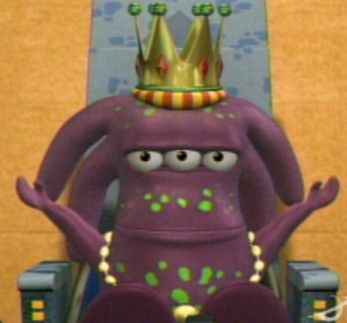 HH) What kind of things would you like to improve upon in a second season?
HH) What kind of things would you like to improve upon in a second season?
BD) The scripts should be better. And the writers should talk more amongst each other so there’s more consistency. There should also be more science fiction writers on board. I’d like to see more back-story about the main characters. But most of these requests are typical for new shows. The first seasons of the Simpson’s and Futurama weren’t that great when compared with later seasons. I think we’ve learned enough from this first season, and that we can make all the adjustments for a better series.
HH) Are there any plans to introduce seasonal or series story arcs to the show, or will it remain episodic?
BD) I believe it will stay episodic
HH) Well thank you for taking the time for this interview, and all the information you provided.
Discuss this interview in
the ‘Tripping the Rift Forum‘
This Tripping the Rift piece is © 2004 Ryan Bechtel and Bernie Denk.
Not for reproduction without the authors express permission
Tripping the Rift names, characters and everything else associated with the series are the property of Chris Moeller, Chuck Austen Film Roman, CineGroup, and the Sci Fi Channel.